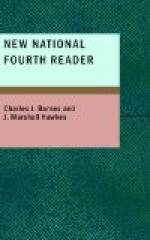It begins to bear fruit about eight years after it has been planted, and continues to be productive from seventy to one hundred years.
Dates are oval in shape, and have a long solid stone. They form the principal food of the inhabitants of some of the eastern countries, and are an important article of commerce.
When they are perfectly ripe, they possess a delightful perfume, and are very agreeable to the taste.
In preparing dates to be sent to distant countries, they are gathered a short time before they are quite ripe, dried in the sun on mats, and finally packed in boxes or straw sacks.
Travelers in the deserts of Africa, often carry dried dates with them for their chief food, during a journey of hundreds of miles.
The Arabs grind dried dates into a powder which they call date flour. If this is packed away in a dry place, it will keep for years, and only has to be moistened with a little water to prepare it for eating.
One of the most valuable and productive of tropical trees is the cocoa-nut palm. It grows largely in both the East and West Indies, and elsewhere throughout the torrid zone.
It rises to a height of from sixty to one hundred feet, and terminates in a crown, of graceful, waving leaves. Some of these leaves reach a length of twenty feet, and have the appearance of gigantic feathers.
The fruit consists of a thick outward husk of a fibrous structure, and within this, is the ordinary cocoa-nut of commerce.
The shell of the nut is hard and woody, and a little over a quarter of an inch in thickness. Next to this shell is the kernel, which is also a shell about half an inch thick, and composed of a white substance very pleasant to the taste. Within this white eatable shell, is a milky liquid, called cocoa-nut milk.
[Illustration]
The cocoa-nut is very useful to the natives of the regions in which it grows. The nuts supply a large portion of their food, and the milky fluid inclosed within, forms a pleasant and refreshing drink.
The shell of the nut is made into cups, and from the kernel, cocoa-nut oil is pressed out and largely used in making soap and for other purposes.
In Ceylon, the tree is cultivated extensively. It is estimated that there are twenty million trees in that island, and that each tree produces about sixty nuts yearly. The wealth of a native is based upon the number of cocoa-nut palms he owns.
Another well-known tropical fruit is the fig, which grows on a bush or small tree about eighteen or twenty feet high.
The fig-tree is now cultivated in all the Mediterranean countries, but the larger portion of the American supply comes from western Asia and the south of France.
The varieties are extremely numerous, and the fruit is of various colors, from deep purple to yellow, or nearly white.
The trees usually bear two crops—one in the early summer, the other in the autumn.




